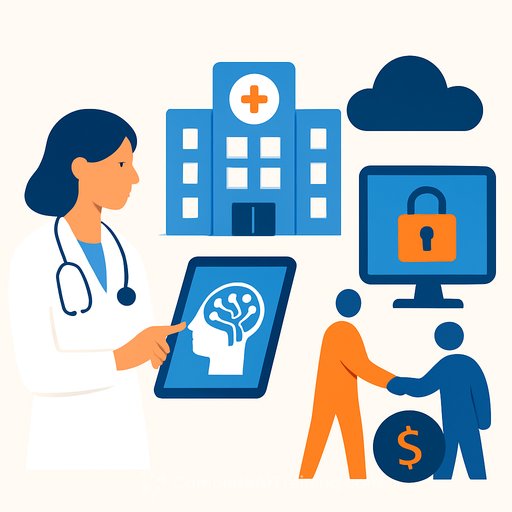Hospitals AI, Cyber Attacks and Smart Hospitals: This Week in Healthcare
Here's what matters for clinical leaders and health IT teams this week: AI moves closer to point-of-care, smart hospital partnerships accelerate, cooling becomes a public health imperative, NHS infrastructure gets more resilient, and ransomware tactics shift.
Medscape AI: Evidence at the Point of Care
Medscape has introduced an AI tool that pulls from its proprietary library and peer-reviewed sources to give clinicians real-time, evidence-based answers. The goal is simple: reduce search time, support clinical judgment, and improve outcomes by cutting through noise.
For clinical teams, the value sits in workflow fit and trust. If it integrates with existing systems, cites sources, and stays current, it can help with differential diagnosis support, medication checks, and patient education in seconds.
- Set guardrails: define use cases (e.g., triage support, order sets) and exclude sensitive decisions where local guidelines apply.
- Validate locally: compare AI outputs against internal protocols; log variances and refine prompts.
- Track impact: measure time saved, adherence to guidelines, and changes in patient outcomes.
- Upskill staff: offer short training on effective questioning and verification. If you need structured options, see AI courses by job role.
Siemens and Samsung C&T: Building Smarter, Leaner Hospitals
Siemens and Samsung C&T signed an MoU to combine digitalisation, electrification and automation across healthcare facilities. Phase one focuses on integrated building automation, energy management and security systems.
Why it matters: unified platforms can cut energy use, stabilise critical environments, and reduce operating costs. For facilities with mixed legacy systems, this is a chance to standardise and prepare for future clinical tech loads.
- Audit your BMS: identify duplicate systems, data silos and manual workarounds.
- Prioritise high impact areas: theatres, imaging, pharmacies, server rooms and isolation wards.
- Plan for interoperability: choose open standards and clear data ownership models.
- Model ROI: include energy savings, maintenance avoidance and downtime reduction.
COP30: Cooling Is Now a Health Strategy
The UN's Global Cooling Watch flags a growing risk: without major shifts in how we cool and heat buildings, climate goals slip out of reach-and health systems face mounting heat-related admissions. An estimated three billion people could still lack reliable cooling by 2050.
For providers, this is both patient safety and infrastructure resilience. Cooling protects vulnerable patients, medication integrity and IT uptime, but it also drives a large share of hospital energy use.
- Adopt a heat-health plan: triggers for surge capacity, patient triage and staff rotation.
- Retrofit for efficiency: high-SEER chillers, heat pumps, smart controls and thermal storage.
- Use passive design: shading, reflective roofs, insulation and airflow improvements.
- Map risk: identify wards and clinics with the highest heat sensitivity and single points of failure.
Further reading: UNEP Global Cooling Watch.
Schneider Electric and DataCentre UK: SWFT Goes Modular
South Warwickshire University NHS Foundation Trust is upgrading digital infrastructure with two modular data centres via Schneider Electric and DataCentre UK. The design uses EcoStruxure components-racks, energy, cooling and management-to boost resilience while supporting sustainability goals.
Modular builds shorten deployment, simplify maintenance and scale with demand from EPR, imaging, AI workloads and remote care. For trusts and IDNs, this is a practical path to stronger uptime without overbuilding.
- Create a tiered strategy: on-prem modular for critical apps, cloud for elasticity, clear failover paths.
- Instrument everything: continuous monitoring for energy, thermal hotspots and capacity planning.
- Design for serviceability: standardised parts, hot-swappable components, clear SLAs.
- Link to ESG: track energy intensity per compute workload and report improvements.
Sophos: Ransomware Shifts to Pure Extortion
Healthcare is seeing fewer encrypted systems and more data theft with ransom demands. Sophos reports extortion-only incidents have tripled since 2023, while encryption fell to 34%-the lowest in five years.
This changes defence priorities. Backups still matter, but the bigger risk is data exposure that disrupts operations and erodes trust.
- Reduce data exposure: least privilege, strict egress controls and data minimisation.
- Strengthen detection: EDR/XDR, anomaly spotting on data exfiltration and segmented networks.
- Test response: tabletops for extortion scenarios, legal/PR workflows and patient notification plans.
- Tighten third-party access: vendor segmentation, short-lived credentials and continuous monitoring.
Further reading: State of Ransomware in Healthcare.
Your 90-Day Action Plan
- Clinical AI: run a 6-week pilot with guardrails, measure time-to-answer and adherence to guidelines.
- Facilities: prioritise an integrated controls roadmap for energy, security and critical environments.
- Cooling: implement a heat-health protocol before peak season; upgrade the highest-risk zones first.
- Digital core: budget a modular capacity buffer for EPR/AI growth; add end-to-end monitoring.
- Cyber: enforce MFA everywhere, restrict data egress, validate offsite backups and run an extortion tabletop.
Healthcare systems that move on these fronts will cut risk, free up staff time and maintain continuity-without waiting for perfect conditions.
Your membership also unlocks:






